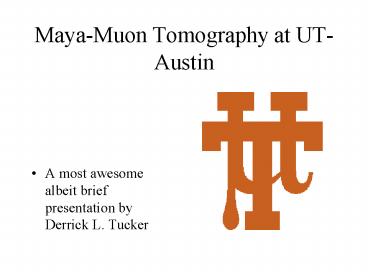MayaMuon Tomography at UTAustin - PowerPoint PPT Presentation
1 / 29
Title:
MayaMuon Tomography at UTAustin
Description:
... Tomography at UT-Austin. A most awesome albeit brief presentation by Derrick L. Tucker ... Differences in the rates from different directions indicates ... – PowerPoint PPT presentation
Number of Views:65
Avg rating:3.0/5.0
Title: MayaMuon Tomography at UTAustin
1
Maya-Muon Tomography at UT-Austin
- A most awesome albeit brief presentation by
Derrick L. Tucker
2
This is applied particle physics!
- As opposed to those other presentations of
fundamental particle physics.
3
Cosmic-Ray Muon Tomography
- What is it exactly?
- It is effectively the use of a particle detector
to track cosmic-ray muon rates for the purpose of
computer-assisted image reconstruction.
4
In our case we track muon count rates at a
variety of different angles and locations.
Differences in the rates from different
directions indicates that the total mass of
material along these directions is thus
different, which we can then use, in theory, to
create tomographic images.
5
Why use muons for tomography?
- Reason 3 - Relatively speaking, they live to a
ripe old age!
6
Why else?
- Reason 2 - Taking into account time-dilation,
muons thus reach sea-level at an approximate rate
of 10,000 muons per square meter per minute.
7
The Final Reason
- And Reason 1 - Energy loss is predominately by
ionization and thus is quantifiable.
8
A brief aside, but where do these muons come from?
- In the atmosphere, muons are produced as the
secondary decay products of mostly protons (sent
from countless explosions and other such
activities beyond our solar disc) interacting
with nuclei in the atmosphere. These
interactions produce pions and kaons, the charged
variety of which then decay into muons.
9
Illustrative Diagram of Muon Production from Pion
10
The Detector Herself
- Isnt she beautiful!
11
One more picture, complete with beautiful people!
12
General Detector Structure
13
Scintillator
- Extruded polystyrene
- Fluoresces when a charged particle passes through
it - Coated with white paint to contain light within
the strip - Carries a groove down the center to house WLS
fiber
14
FEBs/PMTs
- The PMTs collect light from the WLS fibers and
feed these via the circuit board to the front-end
boards (FEBs) in order to digitize the
information.
15
3 Types of FEB signals
- Synch
- Configuration
- Data-Transfer
16
And then . . .
- All these signals then get routed to the Compact
Rio (or simply the Rio), which adds timing
information in the form of a 40 Mhz clock before
feeding said information to an external computer.
17
The Detector, the Muon, and the Pyramid
18
Basic Scheme
- Muons travel through atmosphere
- Muons interact with the rock/ground/pyramid
- Muons then strike the detector
- Hits then get counted and (eventually)
reconstructed into an image
19
(No Transcript)
20
Current Work
- In order to track muon events we are critically
interested in discerning triplets. - A triplet is simply a series of hit strips, one
on each layer, that overlaps at a point.
21
Discerning Triplets
- An event is determined by two triplets, an entry
triplet and an exit triplet.
22
Offline Software
- The offline software, post-Rio, is used at this
point to reject spurious events and noise and,
through algorithms outlined in my term paper,
determine the best entry and exit triplets. The
quantity describing the best triplets is the
quantity, with a lower value representing a
better triplet. - For more information please read my stellar term
paper . . .
23
Offline Software Cont.
- Offline software is developed using C
preliminarily in MatLab before being ported and
updated in Geant4, a toolkit developed at CERN
for particle interaction simulation.
24
2-D Triplet Display
25
Current Work Part DuexTriplets and Doublets
- Our most current work (i.e. this past weekend
current) involves resolving triplets and doublets
in order to increase number of events we can use
to reconstruct events.
26
Triplet/Doublet Discernment
- There must be one triplet associated with said
doublet. - The triplet strike must be clean, that is to
say that not many associated strips can be struck.
27
Future Goals
- Finish detector construction
- Continue testing triplet algorithms and (very
soon) do some rudimentary test imaging - Go to Belize and image the internals of Mayan
pyramids
28
And . . .
- Party in BELIZE!!!
29
THE END!
- For now . . .







![get [PDF] DOWNLOAD Cone Beam Computed Tomography in Endodont PowerPoint PPT Presentation](https://s3.amazonaws.com/images.powershow.com/10084529.th0.jpg?_=20240724058)
![[PDF] READ] Free Cardiovascular Computed Tomography (Oxford Specialist PowerPoint PPT Presentation](https://s3.amazonaws.com/images.powershow.com/10075957.th0.jpg?_=202407100710)
![[PDF] READ] Free Cone Beam Computed Tomography: Oral and Maxillofacial PowerPoint PPT Presentation](https://s3.amazonaws.com/images.powershow.com/10076634.th0.jpg?_=202407110310)





















